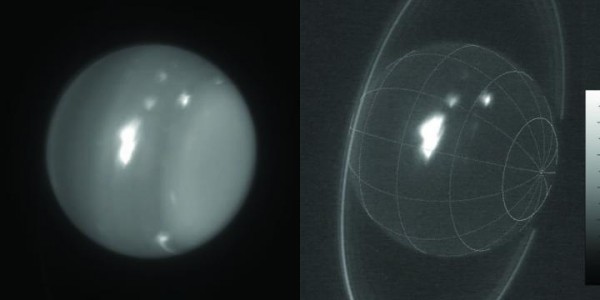Brilliant Storms Reveal More Detail of Uranus
| Marco Foronda | | Nov 13, 2014 10:12 PM EST |
(Photo : Imke de Pater (UC Berkeley) & Keck Observatory images/(newscenter.berkeley.edu)) Infrared images of Uranus (1.6 and 2.2 microns) captured on Aug. 6, 2014. The white spot is an extremely large storm that was brighter than any feature ever recorded on the planet in the 2.2 micron band.
Excited astronomers have noticed that extreme storms on Uranus featuring huge and tremendously brilliant cloud systems are showing them more details about this planet.
The storms revealed the planet's hazy blue-green atmosphere despite Uranus being 30 times farther away from the Sun than our planet.
Like Us on Facebook
Imke de Pater, professor and chair of astronomy at the University of California, Heidi Hammel of the Association of Universities for Research in Astronomy and their team used the Keck Telescope in Hawaii to detect eight large storms raging across the planet's northern hemisphere last August 5 and 6.
Dr. Hammel said this type of activity would have occurred in 2007 when Uranus' once every 42-year equinox occurred and the sun shines directly on the equator.
One of the brightest storms on Uranus they've seen is at 2.2 microns, a wavelength that detects clouds just below the tropopause where pressure ranges from 300 to 500 millibars, or half the pressure at the Earth's surface.
The storm contributed 30 percent of all light reflected by the rest of the planet at this wavelength.
Planetary scientist at the University of Wisconsin Larry Sromovsky said the colors and morphology of the cloud system suggests the storm might be tied to a vortex in the deeper atmosphere, similar to two large cloud complexes seen during the equinox.
Kunio Sayanagi, an Assistant Professor at Hampton University in Virginia and leader of another team of astronomers, activated the "Target of Opportunity" proposal on the Hubble Space Telescope that scanned Uranus on October 14.
HST's observation at a variety of wavelengths revealed numerous storm components over a distance of more than 9,000 kilometers (5,760 miles) and clouds at a variety of altitudes.
Tagsuranus storms, storms, atmosphere, uranus atmosphere, uranus weather, uranus extreme storms, keck observatory, keck telescope, solar system, equinox, Hubble Space Telescope
©2015 Chinatopix All rights reserved. Do not reproduce without permission
EDITOR'S PICKS
-

Did the Trump administration just announce plans for a trade war with ‘hostile’ China and Russia?
-

US Senate passes Taiwan travel bill slammed by China
-

As Yan Sihong’s family grieves, here are other Chinese students who went missing abroad. Some have never been found
-

Beijing blasts Western critics who ‘smear China’ with the term sharp power
-

China Envoy Seeks to Defuse Tensions With U.S. as a Trade War Brews
-

Singapore's Deputy PM Provides Bitcoin Vote of Confidence Amid China's Blanket Bans
-

China warns investors over risks in overseas virtual currency trading
-

Chinese government most trustworthy: survey
-

Kashima Antlers On Course For Back-To-Back Titles
MOST POPULAR
LATEST NEWS
Zhou Yongkang: China's Former Security Chief Sentenced to Life in Prison

China's former Chief of the Ministry of Public Security, Zhou Yongkang, has been given a life sentence after he was found guilty of abusing his office, bribery and deliberately ... Full Article
TRENDING STORY

China Pork Prices Expected to Stabilize As The Supplies Recover

Elephone P9000 Smartphone is now on Sale on Amazon India

There's a Big Chance Cliffhangers Won't Still Be Resolved When Grey's Anatomy Season 13 Returns

Supreme Court Ruled on Samsung vs Apple Dispute for Patent Infringement

Microsoft Surface Pro 5 Rumors and Release Date: What is the Latest?










